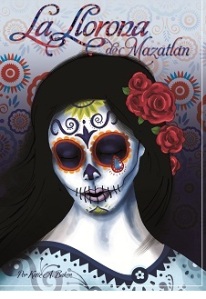This is now my fourth time using La Llorona de Mazatlán by Katie Baker with my Spanish IV classes. While there are standard activities and creations that I use with all of our novels each year, I never do anything the same way twice. This year has been made a bit more complicated since I decided that we would start the year with both FVR and El Internado once a week (as opposed to just second semester), effectively eliminating one day of the week. However, I still want to cover the same amount of material and novels as last year, so I have to really consider how much more I add to each novel! It actually has worked out well, as I have had the students read about half of the novel on their own, and half with the whole class and therefore still been able to add in all the little “extras”. This past week we finished chapters 9 and 10 (the fracturing of the friendship of Laney and Desi and the gift of la pulsera from Luis to Laney). We also have begun our readings of other legends (El Sombrerón, El Cucuy, El Chupacabras) as well as the first versions of La Llorona (thanks to Bryce Hedstrom!). The first part of Chapter 11 is the huge argument between Laney and Desi, when Laney lies about the giver of the gift. My students certainly know the nouns “mentiroso/a” and “mentira” but I did not feel that they were as familiar with the verb “mentir.” With oral assesments coming up, I really want them to be comfortable when talking about the people who lied: Laney and Luis. In addition to that, the lyrics tie in beautifully with the book and the legend of La Llorona: You came into my life to teach me; with eyes closed I followed you; you’re not the person that I thought you were; you hurt me; I’m better off without you. Last year, AFTER the chapter, I used the terrific song Mientes by Camila, and they really enjoyed it. However, I made a note to use it BEFORE the chapter this year, and it worked really well. Note: I did not use the video at any point in time; it is not appropriate and absolutely not needed. Here is the order of what I did.
- Quickly went over present and past tense of mentir, with some PQA

- Shared some memes and images

- Had some discussion about famous liars (I gave them a few, they added more).

- Had some discussion about our own lies, and why we lie

- Talked about consequences of lying; this was deliberate to incorporate some unfamiliar words in the song Mientes: hace daño, conseguiste, quedan ganas

- First listen to the song and work with a traditional cloze chap 11 MIENTES Camila
- After listening to it twice, checking the words that they filled in, and making sure that meaning had been established, most of them were begging to sing it. One of my classes had to sing it three times and we have decided that this week they will come up with gestures for the song.
- Read the first two pages of Chapter 11 (the fight) and was delighted when so many of them started yelling: Mientes, Laney, mientes!
This upcoming week
- Review the song again, singing with all classes, adding gestures with at least one of those classes
- Pull out specific lines to emphasize

- Use Pictograms Chap 11 Mientes picto

- And/or use Pictograms as a game (projected on SMART)
- Act out the fight scene between Laney and Desi, using the actual script in the book first, then creating their own script
If you are interested in seeing the rest of what I have done with La Llorona de Mazatlán this year, use this link. The page is in chronological order so that the most current plans are at the top.


 I have written so many times about music and my teaching. I literally have been using music in my classes for the past 37 years! Yes, I know, I’m ancient. What doesn’t ever get ancient is the music. This post is going to be a bit different. I’m trying to consolidate; instead of writing a post about a specific unit I am going to simply list all of my units and the music that anchors each of them. There is NOT ONE unit that doesn’t begin with music, not one. Music is always part of my “hook”. It may not be the only hook, but it always is one of the hooks and the music “plays” on throughout the entire unit.
I have written so many times about music and my teaching. I literally have been using music in my classes for the past 37 years! Yes, I know, I’m ancient. What doesn’t ever get ancient is the music. This post is going to be a bit different. I’m trying to consolidate; instead of writing a post about a specific unit I am going to simply list all of my units and the music that anchors each of them. There is NOT ONE unit that doesn’t begin with music, not one. Music is always part of my “hook”. It may not be the only hook, but it always is one of the hooks and the music “plays” on throughout the entire unit.


